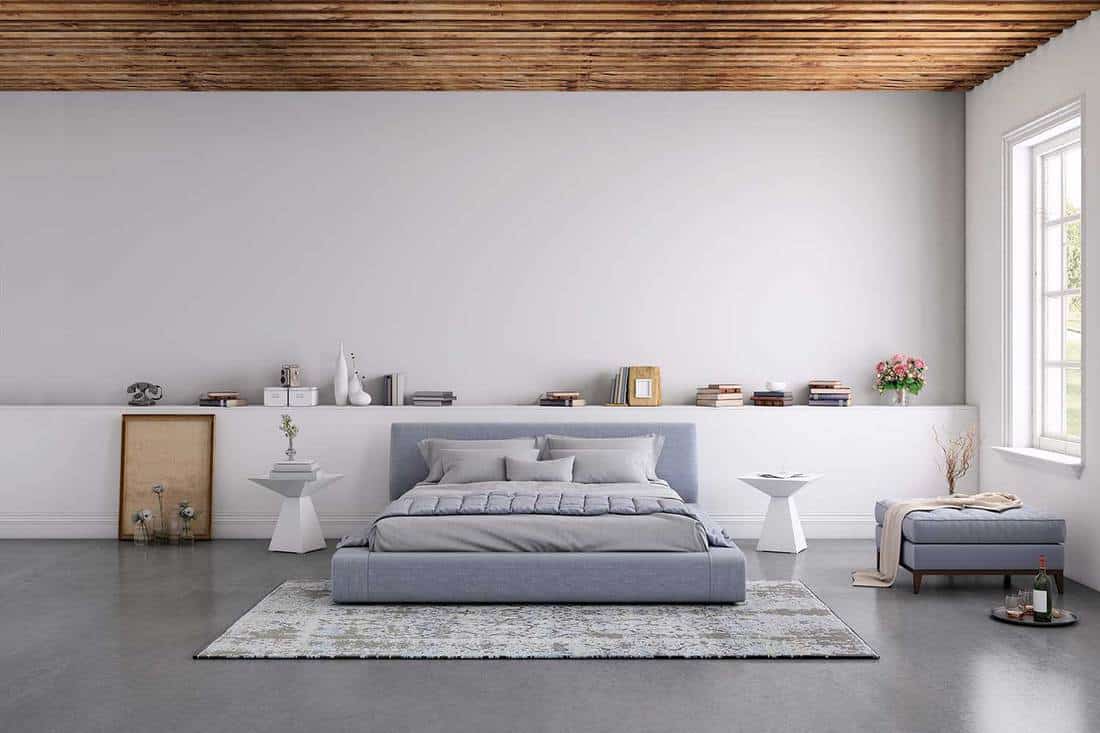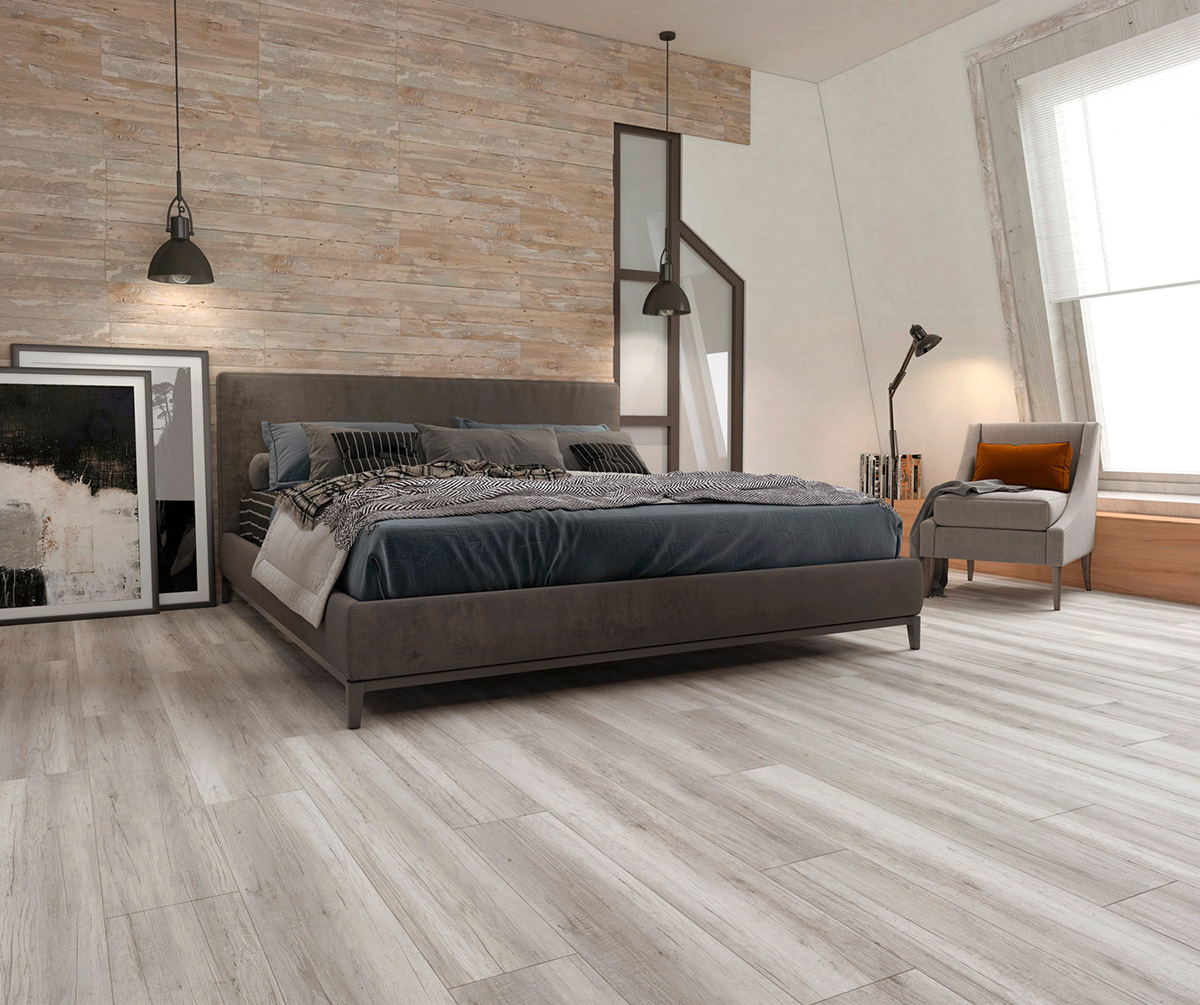Grey Floors and Interior Design: Bedrooms With Grey Floors

Grey floors are a popular choice for bedrooms because of their versatility and ability to complement various color palettes and design styles. Their neutral tone provides a blank canvas for you to express your personal style.
Grey Floors and Color Combinations
Grey floors create a neutral backdrop that allows you to experiment with a wide range of colors in your bedroom. Here are some popular color combinations that work well with grey floors:
- White and Grey: This classic combination creates a clean and modern look. White walls and bedding with grey floors provide a sense of spaciousness and serenity.
- Black and Grey: For a bold and dramatic look, consider using black accents, such as furniture, artwork, or throw pillows, against a backdrop of grey floors and walls.
- Blue and Grey: A combination of blue and grey creates a calming and sophisticated atmosphere. Use shades of blue for bedding, curtains, or accent walls, and let the grey floors ground the space.
- Yellow and Grey: For a cheerful and vibrant look, add pops of yellow to your bedroom with throw pillows, artwork, or a statement piece of furniture. The grey floors will help to balance the bright yellow and prevent the space from feeling overwhelming.
- Pink and Grey: Pink and grey create a chic and feminine look. Use shades of pink for bedding, curtains, or a rug, and let the grey floors provide a grounding element.
Grey Floors and Space
Grey floors can create a sense of spaciousness and sophistication in a bedroom. The neutral tone of grey can make a room feel larger and more airy, especially when paired with light walls and furniture.
Grey Floors and Mood
Grey floors can be used to create different moods and atmospheres in a bedroom. For a calming retreat, use lighter shades of grey and pair them with soft, neutral colors. For a modern and edgy space, use darker shades of grey and incorporate bold accents.
Materials and Finishes for Grey Floors

Grey floors offer a versatile backdrop for a wide range of bedroom styles, from modern and minimalist to traditional and eclectic. The choice of material and finish can significantly impact the overall aesthetic and functionality of your bedroom.
Materials for Grey Floors, Bedrooms with grey floors
The material you choose for your grey floors will influence its durability, maintenance requirements, cost, and aesthetic appeal. Here are some common materials used for grey floors in bedrooms:
- Wood: Wood floors offer a classic and timeless look. They come in various shades of grey, from light and airy to dark and dramatic.
- Pros: Durable, warm underfoot, can be refinished, adds value to a home.
- Cons: Expensive, susceptible to scratches and dents, requires regular maintenance, not suitable for high-moisture areas.
- Tile: Tile floors are known for their durability and ease of maintenance. They are available in a wide range of grey shades and styles, including ceramic, porcelain, and natural stone.
- Pros: Durable, water-resistant, easy to clean, can mimic the look of other materials, affordable.
- Cons: Can be cold underfoot, grout lines can accumulate dirt, may require professional installation.
- Laminate: Laminate flooring is a cost-effective alternative to hardwood. It is made from layers of composite materials and is available in a variety of grey finishes, mimicking the look of wood, stone, or tile.
- Pros: Affordable, easy to install, durable, water-resistant, available in various styles.
- Cons: Not as durable as hardwood, can be susceptible to scratches, not as environmentally friendly as natural materials.
- Concrete: Concrete floors are becoming increasingly popular in modern homes. They can be polished to create a sleek and sophisticated look or left in a raw, industrial style.
- Pros: Durable, low-maintenance, can be stained or painted, environmentally friendly, adds a modern touch.
- Cons: Can be cold underfoot, requires professional installation, may be more expensive than other materials.
Finishes for Grey Floors
The finish you choose for your grey floors will significantly impact the overall look and feel of your bedroom.
- Polished: A polished finish creates a sleek and reflective surface, adding a touch of luxury to a bedroom. It is often used for materials like natural stone or concrete.
- Pros: Adds a sense of sophistication, enhances the natural beauty of the material, reflects light, making the room appear larger.
- Cons: Can be slippery, requires regular cleaning to maintain its shine, may show scratches more easily.
- Matte: A matte finish provides a subtle and understated look, reducing glare and creating a calming ambiance. It is commonly used for materials like wood or tile.
- Pros: Creates a warm and inviting atmosphere, hides imperfections, reduces glare, easy to maintain.
- Cons: May not be as striking as a polished finish, can make the room appear smaller.
- Textured: A textured finish adds depth and dimension to grey floors, creating a tactile experience. It is often used for materials like concrete or tile.
- Pros: Adds visual interest and texture, can create a rustic or industrial feel, hides imperfections, provides slip resistance.
- Cons: May be more difficult to clean, can trap dirt and dust, may not be suitable for all styles.
- Distressed: A distressed finish creates a vintage or aged look, adding character and warmth to a bedroom. It is often used for materials like wood or tile.
- Pros: Adds a sense of history and charm, creates a unique and personalized look, hides imperfections, complements rustic or farmhouse styles.
- Cons: Can be more expensive, may require more maintenance, may not be suitable for all styles.
Lighting and Grey Floors

Grey floors, while versatile and stylish, can be impacted by the way light interacts with their cool undertones. The right lighting can enhance the grey’s subtle nuances, creating a desired ambiance and highlighting the room’s features. Conversely, improper lighting can make the space feel cold, dull, or even sterile.
The Impact of Light on Grey Floors
The appearance of grey floors can be significantly influenced by the type of light source used.
- Natural Light: Daylight tends to bring out the warmer undertones in grey floors, making them appear more inviting and less stark. However, direct sunlight can create harsh shadows and potentially fade the color of the floor over time.
- Warm Artificial Light: Warm white light bulbs (with a color temperature of 2700K to 3000K) can soften the cool tones of grey floors, creating a cozy and inviting atmosphere.
- Cool Artificial Light: Cool white light bulbs (with a color temperature of 4000K to 6500K) can make grey floors appear more stark and cold. This can be desirable in some cases, but it’s important to consider the overall ambiance you want to achieve.
Choosing the Right Lighting Fixtures
Selecting the appropriate lighting fixtures for a bedroom with grey floors involves considering both natural and artificial light sources.
- Maximize Natural Light: Position furniture strategically to allow ample natural light to flow into the space. Consider using sheer curtains or blinds to soften the incoming light and prevent glare.
- Layered Lighting: Create a balanced lighting scheme by incorporating a mix of ambient, task, and accent lighting.
- Ambient Lighting: Provide overall illumination with ceiling fixtures, such as chandeliers, pendant lights, or flush mounts. Opt for warm white bulbs to create a welcoming atmosphere.
- Task Lighting: Install task lights, such as bedside lamps or desk lamps, to provide focused illumination for specific activities.
- Accent Lighting: Use accent lighting, such as sconces or track lighting, to highlight artwork, architectural features, or decorative elements in the room.
- Consider the Color Temperature of Light Bulbs: Choose warm white light bulbs for a cozy and inviting atmosphere, while cool white bulbs can be used to create a more modern and crisp feel.
Using Lighting to Enhance Features and Ambiance
Strategic lighting can effectively highlight specific features of the room and create a desired ambiance.
- Highlighting Architectural Features: Use recessed lighting or wall sconces to illuminate architectural details, such as crown molding or a fireplace mantel.
- Creating a Relaxing Atmosphere: Dim the overall lighting in the evening by using dimmer switches or low-wattage bulbs to create a relaxing and intimate atmosphere.
- Adding Visual Interest: Use accent lighting to highlight artwork, sculptures, or other decorative elements, adding visual interest and depth to the space.
Creating a Balanced Lighting Scheme
A well-balanced lighting scheme complements the grey floor and the overall bedroom design.
- Avoid Harsh Shadows: Ensure sufficient lighting throughout the room to prevent harsh shadows from being cast by the grey floor.
- Consider the Size of the Room: In smaller bedrooms, use brighter lighting to create a sense of spaciousness. In larger bedrooms, use a combination of different lighting sources to create a more intimate feel.
- Experiment with Different Lighting Options: Don’t be afraid to experiment with different lighting fixtures and bulb types until you find a combination that complements the grey floor and creates the desired ambiance for your bedroom.
Bedrooms with grey floors – Grey floors in a bedroom can create a calming and sophisticated atmosphere, but they can also feel a bit stark. To add a touch of warmth and vibrancy, consider incorporating blue valances for bedroom windows. The cool blue hues will complement the grey floors beautifully, creating a sense of serenity and inviting a peaceful ambiance.
This combination will not only add visual interest but also enhance the overall tranquility of your bedroom sanctuary.
Grey floors in a bedroom can create a sense of calm and sophistication, but they can also make the space feel smaller. If you’re looking to maximize your bedroom space, consider a small sofa bed for bedroom. It provides a comfortable seating area during the day and transforms into a bed at night, making it an ideal solution for smaller bedrooms with grey floors.
